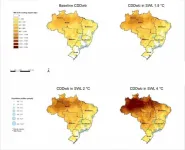(Press-News.org) Commuters now have yet another reason to avoid packing themselves into subway stations. New York City's transit system exposes riders to more inhaled pollutants than any other metropolitan subway system in the Northeastern United States, a new study finds. Yet even its "cleaner" neighbors struggle with enough toxins to give health-conscious travelers pause.
Led by NYU Grossman School of Medicine researchers, the study measured air quality samples in 71 stations at morning and evening rush hours in Boston, New York City, Philadelphia, and Washington, D.C. Among the 13 underground stations tested in New York, the investigators found concentrations of hazardous metals and organic particles that ranged anywhere from two to seven times that of outdoor air samples.
Notably in the report, publishing online Feb. 10 in the journal Environmental Health Perspectives, one underground platform on the PATH line connecting New Jersey and Manhattan (Christopher Street Station) reached up to 77 times the typical concentration of potentially dangerous particles in outdoor, aboveground city air. This figure is comparable to sooty contamination from forest fires and building demolition, the study authors say.
Air quality was also measured in another 58 stations during rush hours in Boston, Philadelphia, and Washington. While no station's readings reached the severe levels of contamination seen in New York's worst transit lines, underground subway stations within each of these cities still showed at least twice the airborne particle concentrations as their respective outside samples at morning and evening rush hours.
"Our findings add to evidence that subways expose millions of commuters and transit employees to air pollutants at levels known to pose serious health risks over time," says study lead author David Luglio, a doctoral student at NYU Grossman.
"As riders of one of the busiest, and apparently dirtiest, metro systems in the country, New Yorkers in particular should be concerned about the toxins they are inhaling as they wait for trains to arrive," adds co-senior study author Terry Gordon, PhD, a professor in the Department of Environmental Medicine at NYU Grossman.
Further analysis of air samples showed that iron and organic carbon, a chemical produced by the incomplete breakdown of fossil fuels or from decaying plants and animals, composed three-quarters of the pollutants found in the underground air samples for all measured subway stations. Although iron is largely nontoxic, some forms of organic carbon have been linked to increased risk of asthma, lung cancer, and heart disease, the study authors say. Gordon notes that further research is needed to assess potentially higher risk for transit workers who spend far longer periods of time in the stations than riders.
The Metropolitan Transit Authority reported that 5.5 million people rode New York City's subways every day in 2019, while PATH puts its daily ridership at more than 284,000.
For the investigation, the research team took over 300 air samples during rush hour in stations in Manhattan, Philadelphia, Washington, Boston, and along train lines connecting New York City to New Jersey and Long Island. The data reflects more than 50 total hours of sampling across about 70 subway stops. In addition to real-time monitoring of the air quality, the team also used filters to collect airborne particles for later analysis.
According to the findings, the PATH-New York/New Jersey system had the highest airborne particle concentration at 392 micrograms per cubic meter, followed by the MTA-New York at 251 micrograms per cubic meter. Washington had the next highest levels at 145 micrograms per cubic meter, followed by Boston at 140 micrograms per cubic meter. Philadelphia was comparatively the cleanest system at 39 micrograms per cubic meter. By comparison, aboveground air concentrations for all measured cities averaged just 16 micrograms per cubic meter.
Meanwhile, the Environmental Protection Agency advises that daily exposures at fine particle concentrations exceeding 35 micrograms per cubic meter pose serious health hazards.
Besides the Christopher Street PATH station, the most polluted stations in the Northeast included Capitol South in Washington, Broadway in Boston, 2nd Avenue on the F line New York City, and 30th Street in Philadelphia, according to the findings.
Gordon cautions that the researchers did not measure riders' short-term exposure to the airborne substances, which would more closely mimic their experiences dashing to catch a train at the last minute. In addition, it remains unclear whether the steep drop in New York subway ridership due to the COVID-19 pandemic has influenced the metro's air quality, he adds.
Next, Gordon says he plans to investigate sources of subway station air contamination, such as exhaust given off by diesel maintenance locomotives, whipped up dust from the remains of dead rodents, and poor ventilation as potential culprits. He also encourages researchers and transit authorities to examine why some systems are less polluted than others in a bid to adopt practices that might relatively quickly make stations safer for riders.
INFORMATION:
Funding for the study was provided by National Institute of Environmental Health Sciences grants P30 ES000260, P30 ES009089, and T32 ES007324.
In addition to Gordon and Luglio, other NYU Grossman researchers include Maria Katsigeorgis; Jade Hess; Rebecca Kim; John Adragna, George Thurston, Colin Gordon, and Amna Raja. Jonathan Fine, MD, at Norwalk Hospital in Norwalk, Conn., was also involved in the study. M.J. Ruzmyn Vilcassim, PhD, at the University of Alabama in Birmingham served as the study co-senior author.
Media Inquiries
Shira Polan
212-404-4279
shira.polan@nyulangone.org
A treatment, known as KEDRAB (Rabies Immune Globulin [Human]), currently used in the prevention of rabies has been demonstrated to be safe and effective for patients age 17 and under.
Results published today in Human Vaccines & Immunotherapeutics report the first and only pediatric trial of any human rabies immunoglobulin (HRIG) currently available in the US. Findings have been submitted to the US Food and Drug Administration for review.
In the United States, someone is treated for possible exposure to rabies every 10 minutes. Globally, the World ...
A new paper in Oxford Open Immunology, published by Oxford University Press, examines prior findings in the field of neuroimmunology that suggest potential treatment strategies for patients suffering long-term symptoms from COVID-19.
Though COVID-19 was initially believed to be a short-term illness, lasting between one and three weeks, it's clear that a substantial number of patients will experience symptoms beyond that, with some patients suffering from health problems for more 12 weeks. In fact, for patients who were initially hospitalized, more than 80% reported at least one symptom that persisted beyond the first month.
The symptoms of long-COVID can vary widely, ...
Yams are a staple food in West Africa, which produces over 90% of the world's yams each year. Yams play a key role in the food security, economic income, and traditional culture for the region.
While they are commonly assumed to be the same as sweet potatoes in the U.S., yams are a completely different plant. The yam tubers are much starchier and drier compared to sweet potatoes. Yams are native to Africa and Asia, and most Americans have never had a true yam.
Even though yam is a staple crop for West Africa, there has been limited research to improve the genetic diversity or productivity.
Researcher Shinsuke Yamanaka focuses on improving crop breeding resources for ...
Tungsten hexanitride with armchairlike hexazine N6 ring has been synthesized by a group of scientists led by Dr. Jin Liu and his former postdoc Nilesh Salke at HPSTAR (Center for High Pressure Science & Technology Advanced Research). WN6 is a promising high-energy-density and superhard material. Their findings are published in the recent issue of Physical Review Letters.
Diatomic nitrogen is the most abundant molecule in Earth's atmosphere accounting for almost 78% volume. The strong triple bond in nitrogen makes it very stable and unreactive at near ambient conditions. However, in the intense-pressure and high-temperature conditions, nitrogen will behave entirely differently, it can form double- or even single-bonded structure or react with other elements ...
As abundant and widespread bees, it is common to see both bumble bees and honey bees foraging on the same flower species during the summer, whether in Britain or many other countries.
Yet researchers at the Laboratory of Apiculture and Social Insects (LASI) at the University of Sussex, have found that different bees dominate particular flower species and revealed why.
By studying 22 flower species in southern England and analysing the behaviour of more than 1000 bees, they found that 'energy efficiency' is a key factor when it comes to mediating competition.
Bee bodyweight and the rate at which a bee visits flowers determine how energy efficient they are. Bodyweight determines the energy used while flying and walking between flowers, with a bee ...
Space cooling already accounts for 14% of residential electricity demand in Brazil, and it is expected to increase further because of climate change.
Very few studies investigate the relationship between climate change, cooling needs, and electricity demand. In a new study in Energy and Buildings, a team of researchers from Universidade Federal do Rio de Janeiro and CMCC@Ca'Foscari - a joint program of Ca'Foscari University of Venice and CMCC Foundation - investigate how climate and income during the period 1970-2010 shaped cooling services in Brazil. This historical relationship allows projecting the resulting energy demand for cooling services across three warming scenarios: +1.5°C, +2°C, +4°C.
The study shows ...
WEST LAFAYETTE, Ind. - Emerging robotics technology may soon help construction companies and contractors create buildings in less time at higher quality and at lower costs.
Purdue University innovators developed and are testing a novel construction robotic system that uses an innovative mechanical design with advances in computer vision sensing technology to work in a construction setting.
The technology was developed with support from the National Science Foundation.
"Our work helps to address workforce shortages in the construction industry by automating key construction operations," said Jiansong Zhang, an assistant professor of construction ...
The findings add to current knowledge of how insects fly and keep stable in the air. They could also help to inspire new designs in small aerial vehicles like drones, which can be useful for search-and-rescue attempts and building inspection.
Our colourful sunny-day companions can glide, fly backwards, and travel up to 54 km/h when hunting prey or escaping predators - but like any flying creature, they can be thrown off balance and even find themselves upside down.
Many land-based animals like cats, and aerial animals like hoverflies, rotate themselves around a head-to-tail ...
During a study with captive vampire bats at the Smithsonian Tropical Research Institute (STRI) in Panama, a young vampire bat pup was adopted by an unrelated female after its mother died. Although this observation was not the first report of adoption in vampire bats, it is uniquely contextualized by more than 100 days of surveillance-camera footage. This footage captured by STRI research associate Gerry Carter's lab at Ohio State University reveals intimate details about the changing social relationships between the mother, the pup and the adoptive mother throughout their time in captivity.
"The adoption took place after a very sad but ultimately serendipitous occurrence," ...
Adopting policies that are consistent with achieving the Paris Agreement and prioritise health, could save 6.4 million lives due to better diet, 1.6 million lives due to cleaner air, and 2.1 million lives due to increased exercise, per year, across nine countries.
New research from The Lancet Countdown on Health and Climate Change published in a special issue of The Lancet Planetary Health journal highlights the benefits to health if countries adopt climate plans - Nationally Determined Contributions (NDCs) - that are consistent with the Paris Agreement aim of limiting warming to "well below 2°C". [1,2]
The countries considered in the study represent ...




